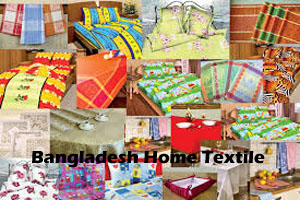
Bangladesh home textile sector faces negative growth in first 2 month of FY2014-15
YarnsandFibers News Bureau 2014-10-09 14:00:00 – DhakaBangladesh home textile sector faces negative growth during the first two months of the current fiscal year 2014-15. The major factors which count for blocking the growth of country’s potential home textile exports are European Union GSP facility for Pakistan, appreciation of the local currency against the US dollar and recent political turmoil.
According to Jahangir Alamin, President of Bangladesh Textile Mills Association, Bangladeshi-made home textiles are lagging behind Pakistan in terms of cost-competitiveness, one of the major causes of setback.
Moreover, the appreciation of taka against the dollar and recent political instability also cast a negative impact on the overall export growth in this sector.
The industry fetched $115.99 million in July-August period of the current fiscal, showing a 0.79 per cent negative growth compared to the same period of last fiscal, as per the data of Export Promotion Bureau (EPB).
In the just-concluded fiscal year 2013-14, the country received $792.53 million from home-textile exports. The figure was $791.52 million in FY 2012-13.
Earnings stood at $906.07 million in FY of 2011-12, some $788.76 million in 2010-11, $539.28 million in 2009-10 and $313.51million in 2008-09 respectively.
According to a recent study by Bangladesh Foreign Trade Institute (BFTI) Bangladesh is likely to face strong competitive pressure from Pakistan in home-textile trade.
Pakistan has used the new GSP scheme more effectively than Bangladesh. Bangladesh's export to the EU market during the first five months of current calendar year grew by 11 percent while Pakistan's by 27 percent.
Due to the EU's new GSP scheme, Pakistan will be the main competitor of Bangladesh on the EU market and Bangladesh may face pressure in the days to come. Home-textile products will be the main victim of the new system, said BFTI director Dr Mostafa Abid Khan.
The buyers were worried over timely supply on their orders due to the political turmoil for last two years. During the period, many of them have shifted a portion of their orders to other destinations, he added.
Besides, an inadequate supply of gas and power to industrial units severely hampers production. The fuel crunch forced many to generate energy by alternative means, resulting in a rise in the cost of production.
The western consumers' buying capacity also plunged in recent times due to economic recession over there. This resulted in a declining demand for such products.
According to Zaber and Zubair Fabrics, country's largest home-textile maker, export of home textiles during recent years increased in terms of value because the buyers paid higher due to the price hike of raw materials such as raw cotton and yarn.
Home-textile-export growth remained stagnant during the last two fiscal years, but quantity of export did not decline. Now the prices of raw materials have fallen, so the rates of products.
According to BTMA, some 17 mills produce about 556.39 million metres of home textiles annually. Bangladesh exports home textiles such as bed-sheets, bedcovers, pillow covers, cushion covers, curtains, rugs, quilt, kitchen aprons, gloves, napkins and tablecloths to European Union countries, the USA, Canada, Mexico, Australia, Japan and Dubai.
Bangladesh is the leader on the EU market but yet to grab the US one.
Market Intelligence
Ask for free sample Report

experience
Customer Base
dedicated team
Countries Served Worldwide









